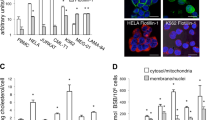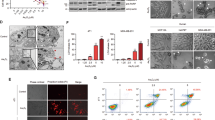Abstract
Arsenic trioxide (As2O3) is toxic to multidrug-resistant neuroblastoma cells in vivo and in vitro. In neuroblastoma, As2O3 does not exert its cell death-promoting effects via a classical apoptotic pathway. A death mechanism involving proteolytic cleavage of Bax to a p18 form seems to be of importance, because inhibition of Bax cleavage coincides with diminished cell death. As existing models of cell death implicate Bax in the intrinsic apoptotic pathway, triggering death after Bax translocation to the mitochondria, we investigated the cellular localization of p18 Bax by subcellular fractionation. After As2O3 treatment, p18 Bax was only present in nuclei-enriched, mitochondria-depleted fractions. Cytoplasmic p21 Bax levels decreased, whereas total (p21 and p18) nuclear Bax increased. Overexpressed p21 Bax localized to the cytoplasm and nuclei, whereas overexpressed p18 Bax localized to extra-nuclear structures only. The inability of overexpressed p18 Bax to locate to the nucleus, and the As2O3-induced reduction of p21 Bax in the cytosol, suggest an As2O3-induced mechanism where p18 Bax gets cleaved and ‘trapped’ in the nucleus. This model is strengthened by the observation that calpain, the protease responsible for p18 Bax generation, is present in the nuclei, and that nuclear calpain is induced by increasing As2O3 and Ca2+ levels.
This is a preview of subscription content, access via your institution
Access options
Subscribe to this journal
Receive 50 print issues and online access
$259.00 per year
only $5.18 per issue
Buy this article
- Purchase on Springer Link
- Instant access to full article PDF
Prices may be subject to local taxes which are calculated during checkout





Similar content being viewed by others
References
Breckenridge DG, Germain M, Mathai JP, Nguyen M, Shore GC . (2003). Regulation of apoptosis by endoplasmic reticulum pathways. Oncogene 22: 8608–8618.
Cai X, Shen YL, Zhu Q, Jia PM, Yu Y, Zhou L et al. (2000). Arsenic trioxide-induced apoptosis and differentiation are associated respectively with mitochondrial transmembrane potential collapse and retinoic acid signaling pathways in acute promyelocytic leukemia. Leukemia 14: 262–270.
Cao X, Deng X, May WS . (2003). Cleavage of Bax to p18 Bax accelerates stress-induced apoptosis, and a cathepsin-like protease may rapidly degrade p18 Bax. Blood 102: 2605–2614.
Cartron PF, Oliver L, Juin P, Meflah K, Vallette FM . (2004). The p18 truncated form of Bax behaves like a Bcl-2 homology domain 3-only protein. J Biol Chem 279: 11503–11512.
Cartron PF, Priault M, Oliver L, Meflah K, Manon S, Vallette FM . (2003). The N-terminal end of Bax contains a mitochondrial-targeting signal. J Biol Chem 278: 11633–11641.
Choi WS, Lee EH, Chung CW, Jung YK, Jin BK, Kim SU et al. (2001). Cleavage of Bax is mediated by caspase-dependent or -independent calpain activation in dopaminergic neuronal cells: protective role of Bcl-2. J Neurochem 77: 1531–1541.
Cohen MH, Hirschfeld S, Flamm Honig S, Ibrahim A, Johnson JR, O'Leary JJ et al. (2001). Drug approval summaries: arsenic trioxide, tamoxifen citrate, anastrazole, paclitaxel, bexarotene. Oncologist 6: 4–11.
Feldstein AE, Werneburg NW, Canbay A, Guicciardi ME, Bronk SF, Rydzewski R et al. (2004). Free fatty acids promote hepatic lipotoxicity by stimulating TNF-alpha expression via a lysosomal pathway. Hepatology 40: 185–194.
Friedrich P . (2004). The intriguing Ca2+ requirement of calpain activation. Biochem Biophys Res Commun 323: 1131–1133.
Gao G, Dou QP . (2000). N-terminal cleavage of bax by calpain generates a potent proapoptotic 18-kDa fragment that promotes bcl-2-independent cytochrome C release and apoptotic cell death. J Cell Biochem 80: 53–72.
Gobeil S, Boucher CC, Nadeau D, Poirier GG . (2001). Characterization of the necrotic cleavage of poly(ADP-ribose) polymerase (PARP-1): implication of lysosomal proteases. Cell Death Differ 8: 588–594.
Goll DE, Thompson VF, Li H, Wei W, Cong J . (2003). The calpain system. Physiol Rev 83: 731–801.
Green DR, Reed JC . (1998). Mitochondria and apoptosis. Science 281: 1309–1312.
Ho YS, Lee HM, Chang CR, Lin JK . (1999). Induction of Bax protein and degradation of lamin A during p53-dependent apoptosis induced by chemotherapeutic agents in human cancer cell lines. Biochem Pharmacol 57: 143–154.
Hockenbery D, Nunez G, Milliman C, Schreiber RD, Korsmeyer SJ . (1990). Bcl-2 is an inner mitochondrial membrane protein that blocks programmed cell death. Nature 348: 334–336.
Karlsson J, Edsjö A, Påhlman S, Pettersson HM . (2005). Multidrug-resistant neuroblastoma cells are responsive to arsenic trioxide at both normoxia and hypoxia. Mol Cancer Ther 4: 1128–1135.
Karlsson J, Øra I, Pörn-Ares I, Påhlman S . (2004). Arsenic trioxide-induced death of neuroblastoma cells involves activation of Bax and does not require p53. Clin Cancer Res 10: 3179–3188.
Keshelava N, Seeger RC, Groshen S, Reynolds CP . (1998). Drug resistance patterns of human neuroblastoma cell lines derived from patients at different phases of therapy. Cancer Res 58: 5396–5405.
Keshelava N, Zuo JJ, Chen P, Waidyaratne SN, Luna MC, Gomer CJ et al. (2001). Loss of p53 function confers high-level multidrug resistance in neuroblastoma cell lines. Cancer Res 61: 6185–6193.
Mandal M, Adam L, Mendelsohn J, Kumar R . (1998). Nuclear targeting of Bax during apoptosis in human colorectal cancer cells. Oncogene 17: 999–1007.
Mattaj IW . (2004). Sorting out the nuclear envelope from the endoplasmic reticulum. Nat Rev Mol Cell Biol 5: 65–69.
Matthay KK, Villablanca JG, Seeger RC, Stram DO, Harris RE, Ramsay NK et al. (1999). Treatment of high-risk neuroblastoma with intensive chemotherapy, radiotherapy, autologous bone marrow transplantation, and 13-cis-retinoic acid. Children's Cancer Group. N Engl J Med 341: 1165–1173.
Miller Jr WH, Schipper HM, Lee JS, Singer J, Waxman S . (2002). Mechanisms of action of arsenic trioxide. Cancer Res 62: 3893–3903.
Mishra S, Murphy LC, Nyomba BL, Murphy LJ . (2005). Prohibitin: a potential target for new therapeutics. Trends Mol Med 11: 192–197.
Niu C, Yan H, Yu T, Sun HP, Liu JX, Li XS et al. (1999). Studies on treatment of acute promyelocytic leukemia with arsenic trioxide: remission induction, follow-up, and molecular monitoring in 11 newly diagnosed and 47 relapsed acute promyelocytic leukemia patients. Blood 94: 3315–3324.
Oh SH, Lee BH, Lim SC . (2004). Cadmium induces apoptotic cell death in WI 38 cells via caspase-dependent Bid cleavage and calpain-mediated mitochondrial Bax cleavage by Bcl-2-independent pathway. Biochem Pharmacol 68: 1845–1855.
Øra I, Bondesson L, Jönsson C, Ljungberg J, Pörn-Ares I, Garwicz S et al. (2000). Arsenic trioxide inhibits neuroblastoma growth in vivo and promotes apoptotic cell death in vitro. Biochem Biophys Res Commun 277: 179–185.
Pearson ADJ, Philip T . (2000). Prognosis of low-risk and high-risk neuroblastoma. In: Brodeur GM, Savada T, Tsuchida Y, Voûte PA (eds). Neuroblastoma. Elsevier Science B.V.: Amsterdam, The Netherlands, pp 551–560.
Philip T, Ladenstein R, Lasset C, Hartmann O, Zucker JM, Pinkerton R et al. (1997). 1070 myeloablative megatherapy procedures followed by stem cell rescue for neuroblastoma: 17 years of European experience and conclusions. European Group for Blood and Marrow Transplant Registry Solid Tumour Working Party. Eur J Cancer 33: 2130–2135.
Poot M, Gibson LL, Singer VL . (1997). Detection of apoptosis in live cells by MitoTracker red CMXRos and SYTO dye flow cytometry. Cytometry 27: 358–364.
Raffo AJ, Kim AL, Fine RL . (2000). Formation of nuclear Bax/p53 complexes is associated with chemotherapy induced apoptosis. Oncogene 19: 6216–6228.
Scorrano L, Oakes SA, Opferman JT, Cheng EH, Sorcinelli MD, Pozzan T et al. (2003). BAX and BAK regulation of endoplasmic reticulum Ca2+: a control point for apoptosis. Science 300: 135–139.
Shah GM, Shah RG, Poirier GG . (1996). Different cleavage pattern for poly(ADP-ribose) polymerase during necrosis and apoptosis in HL-60 cells. Biochem Biophys Res Commun 229: 838–844.
Shen ZX, Chen GQ, Ni JH, Li XS, Xiong SM, Qiu QY et al. (1997). Use of arsenic trioxide (As2O3) in the treatment of acute promyelocytic leukemia (APL): II. Clinical efficacy and pharmacokinetics in relapsed patients. Blood 89: 3354–3360.
Soignet SL, Maslak P, Wang ZG, Jhanwar S, Calleja E, Dardashti LJ et al. (1998). Complete remission after treatment of acute promyelocytic leukemia with arsenic trioxide. N Engl J Med 339: 1341–1348.
Susin SA, Lorenzo HK, Zamzami N, Marzo I, Snow BE, Brothers GM et al. (1999). Molecular characterization of mitochondrial apoptosis-inducing factor. Nature 397: 441–446.
Toyota H, Yanase N, Yoshimoto T, Moriyama M, Sudo T, Mizuguchi J . (2003). Calpain-induced Bax-cleavage product is a more potent inducer of apoptotic cell death than wild-type Bax. Cancer Lett 189: 221–230.
Tweddle DA, Malcolm AJ, Bown N, Pearson AD, Lunec J . (2001). Evidence for the development of p53 mutations after cytotoxic therapy in a neuroblastoma cell line. Cancer Res 61: 8–13.
Vandesompele J, De Paepe A, Speleman F . (2002). Elimination of primer-dimer artifacts and genomic coamplification using a two-step SYBR green I real-time RT-PCR. Anal Biochem 303: 95–98.
Wang S, Fusaro G, Padmanabhan J, Chellappan SP . (2002). Prohibitin co-localizes with Rb in the nucleus and recruits N-CoR and HDAC1 for transcriptional repression. Oncogene 21: 8388–8396.
Wood DE, Newcomb EW . (2000). Cleavage of Bax enhances its cell death function. Exp Cell Res 256: 375–382.
Wood DE, Thomas A, Devi LA, Berman Y, Beavis RC, Reed JC et al. (1998). Bax cleavage is mediated by calpain during drug-induced apoptosis. Oncogene 17: 1069–1078.
Zhang TD, Chen GQ, Wang ZG, Wang ZY, Chen SJ, Chen Z . (2001). Arsenic trioxide, a therapeutic agent for APL. Oncogene 20: 7146–7153.
Acknowledgements
This work was supported by grants from the Swedish Cancer Society, Children's Cancer Foundation of Sweden, Hans von Kantzows stiftelse and the Malmö University Hospital research funds.
Author information
Authors and Affiliations
Corresponding author
Rights and permissions
About this article
Cite this article
Karlsson, J., Pietras, A., Beckman, S. et al. Arsenic trioxide-induced neuroblastoma cell death is accompanied by proteolytic activation of nuclear Bax. Oncogene 26, 6150–6159 (2007). https://doi.org/10.1038/sj.onc.1210439
Received:
Revised:
Accepted:
Published:
Issue Date:
DOI: https://doi.org/10.1038/sj.onc.1210439
Keywords
This article is cited by
-
MicroRNA-dependent regulation of PTEN after arsenic trioxide treatment in bladder cancer cell line T24
Tumor Biology (2011)
-
Hypoxia Ischemia-Mediated Cell Death in Neonatal Rat Brain
Neurochemical Research (2008)



